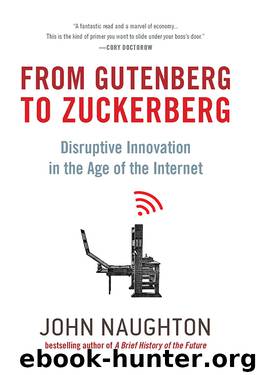From Gutenberg to Zuckerberg by John Naughton

Author:John Naughton [Naughton, John]
Language: eng
Format: epub, azw3, mobi
Tags: History
ISBN: 9781623650636
Publisher: Quercus
Published: 2013-11-25T05:00:00+00:00
The user’s journey
For individuals, the story starts with e-mail—the Internet’s first “killer app.” Up to the mid-1990s, anyone outside of the world of mainframe computers who wanted to send and receive e-mail did so via a special program (called a “client” in computer-speak) that ran on her or his PC.
This was fine for people operating from home, but it had significant downsides for employees who were compelled to use their organizations’ computers for e-mail when they were at work. Among other things, their employers were able to monitor all e-mail messages sent “on company time” or via its networks; and many companies specifically prohibited workers from using company e-mail for personal purposes.
Silicon Valley legend has it that this degree of employer surveillance was particularly irksome to geeks, as it made it difficult for them to look for work in other companies during office hours. As the first Internet boom got under way in 1994, there was a hiring frenzy in the Valley—which meant that anyone with software engineering skills effectively found themselves in a seller’s market. In such circumstances, companies took exception to employees using their e-mail systems to send out job applications and résumés (CVs) to competitors. And the legend says that this is what motivated two ex-Apple engineers, Sabeer Bhatia and Jack Smith, to invent a completely different way of doing e-mail. Initially, they called it HoTMaiL—with the capitalized letters (HTML) spelling out the acronym for HyperText Markup Language, the formatting language used for creating web pages, but it rapidly became known simply as Hotmail.
To anyone accustomed to a PC-based e-mail client, Hotmail was a revelation. It was a pure Web application. To access it, all you needed was a PC—any PC—that had an Internet connection and a Web browser like Mosaic, Netscape, or Internet Explorer (the dominant browsers of the time). You pointed the browser at www.hotmail.com and this took you to the mother ship, somewhere out on the Internet. There you could register for a free account ([email protected]), or sign in if you already had one. Upon logging in, your mail was displayed in the browser in a tidy list. Click on an item and it opened up for reading. Another click and a form opened up for your reply. Once you had finished typing, a click on Send dispatched it on its way. And then you logged out, and nobody was any the wiser about what you had been up to.
Hotmail was launched on Independence Day 1996, and spread like wildfire. In part this was due to a clever marketing trick dreamed up by Bhatia and the company’s marketing agency, Draper Fisher Jurvetson: the system automatically added a footnote to every e-mail revealing that the message had been sent by Hotmail and encouraging the recipient to get a free Hotmail account at www.hotmail.com. This wheeze was later dignified by the term “viral marketing.” But mainly Hotmail spread because it was such a lovely, simple idea. It was such a good idea, in fact, that Microsoft bought it for $400 million in December 1997, and it now lives on as Windows Live Hotmail.
Download
From Gutenberg to Zuckerberg by John Naughton.azw3
From Gutenberg to Zuckerberg by John Naughton.mobi
This site does not store any files on its server. We only index and link to content provided by other sites. Please contact the content providers to delete copyright contents if any and email us, we'll remove relevant links or contents immediately.
Kotlin in Action by Dmitry Jemerov(17308)
Grails in Action by Glen Smith Peter Ledbrook(15466)
Sass and Compass in Action by Wynn Netherland Nathan Weizenbaum Chris Eppstein Brandon Mathis(13330)
Azure Containers Explained by Wesley Haakman & Richard Hooper(7500)
Configuring Windows Server Hybrid Advanced Services Exam Ref AZ-801 by Chris Gill(7497)
Running Windows Containers on AWS by Marcio Morales(7054)
Microsoft 365 Identity and Services Exam Guide MS-100 by Aaron Guilmette(5436)
Microsoft Cybersecurity Architect Exam Ref SC-100 by Dwayne Natwick(5275)
Combating Crime on the Dark Web by Nearchos Nearchou(5018)
The Ruby Workshop by Akshat Paul Peter Philips Dániel Szabó and Cheyne Wallace(4701)
Management Strategies for the Cloud Revolution: How Cloud Computing Is Transforming Business and Why You Can't Afford to Be Left Behind by Charles Babcock(4550)
Python for Security and Networking - Third Edition by José Manuel Ortega(4274)
The Age of Surveillance Capitalism by Shoshana Zuboff(4253)
Learn Wireshark by Lisa Bock(4176)
Learn Windows PowerShell in a Month of Lunches by Don Jones(4077)
The Ultimate Docker Container Book by Schenker Gabriel N.;(3920)
Ember.js in Action by Joachim Haagen Skeie(3677)
DevSecOps in Practice with VMware Tanzu by Parth Pandit & Robert Hardt(3612)
Windows Ransomware Detection and Protection by Marius Sandbu(3579)
